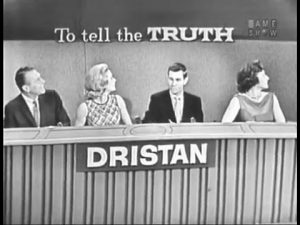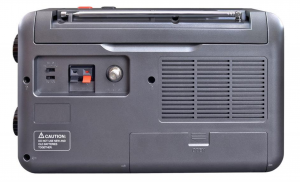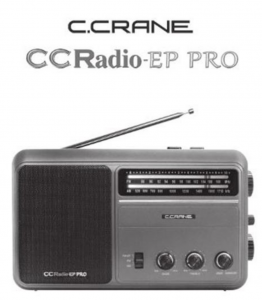Remember the American television game show To Tell The Truth? This very long-running show challenged four celebrity guests and viewers to identify the real “central character” in the midst of two impostors. I was reminded of this game show when attempting to tell the difference between the original and recently updated versions of C. Crane’s CCRadio-EP Pro receiver when viewing the front panels. If there’s a difference, I can’t spot it! You need to turn around the radios to see the new EP-Pro’s key feature: switchable 9 kHz/10 kHz tuning steps.
I was reminded of this game show when attempting to tell the difference between the original and recently updated versions of C. Crane’s CCRadio-EP Pro receiver when viewing the front panels. If there’s a difference, I can’t spot it! You need to turn around the radios to see the new EP-Pro’s key feature: switchable 9 kHz/10 kHz tuning steps.

The only clue to the newest version of the CCRadio-EP Pro is the 9/10 kHz tuning switch on the back panel.
I recently met with a good friend and radio hobbyist from Oregon to compare a few selected portable radios, FSL (Ferrite Sleeve Loop) antennas, and the newest low-noise Wellbrook ALA100LN module that was introduced just a few weeks ago. I was particularly interested in a head-to-head match-up of my friend’s original EP-Pro versus my newly arrived EP-Pro (9 kHz/10 kHz steps) version.
I’m looking forward to Thomas’ usual thorough review of the new CCRadio-EP Pro, but I want to offer a few observations of medium wave tuning after my time with the two models:
- On very weak daytime MW signals, the radios are equally sensitive except on higher frequencies where the new model excels to a moderate degree. It’s enough of an advantage to make the difference between catching an ID or not on a low, DX-level signal.
- The new EP-Pro feels more accurate–and simply more enjoyable–to tune, thanks to the elimination of false “peaks” surrounding the main signal. This is a BIG plus for the new radio, and frankly the CCRadio-EP should have performed this way from the start. Kudos to C. Crane for correcting this problem, but I can understand why the original version was brought to market with the odd tuning quirk. It isn’t a deal breaker for most non-DXing purchasers.
- I could not find an instance of soft muting on either radio. I listened for a while to signals barely above the noise floor, and never did audio “cut in and out” suddenly, a clue to soft muting. Both receivers are very useful for chasing weak MW stations…but the new version is highly preferred for ease of tuning because of the lack of false audio peaks.
- With the tuning working way it should, medium wave channels “snap” in and out as you slowly tune. This took a little getting used to, but after a while I began to appreciate the sense of exactness with the newest CCRadio-EP Pro.
- Fast excursions up or down the band (either radio) will blank the audio, recovering when you stop tuning or slow down. I believe this is simply a case of exceeding the AGC’s recovery time, not soft muting. It’s easy to live with, but granted the effect is not one of smoothness as found on traditional, non-DSP analog receivers. Successful DXing takes a slower approach anyway when scanning the band; casual listeners may be more annoyed by either version of the radio if they are used to very quick knob-cranking.
- The Twin Coil Ferrite “AM Fine Tuning” control works well on both units, and gives significant gain to weak signals on either extremity of the band. I love this feature; it makes digging out the weak ones a lot more fun!
So, should you buy the newest CCRadio-EP Pro with the 9 kHz/10 kHz steps?
- If you already own a CCRadio-EP Pro and are fine with the false tuning peaks and have no desire for the 9 kHz MW step option–keep your radio! Only on high band does the new model have a sensitivity edge. Especially don’t make the jump if you’re a casual listener and listen only to a handful of local stations, or a single distant station.
- If you do not own a CCRadio-EP Pro yet, but are in the market, definitely buy the newest version. Be aware that you can only be assured of getting the newest model if you purchase directly from C. Crane. Amazon does not yet carry the newest version according to some reports.
- If you’re a radio junkie and just have to have both…go ahead…we understand!

I also made a short video comparison of the new EP Pro versus the top-ranked Panasonic RF-2200 on medium wave:
https://www.youtube.com/watch?v=zbZ-06uBsNs
Guy Atkins is a Sr. Graphic Designer for T-Mobile and lives near Seattle, Washington. He’s a regular contributor to the SWLing Post.

The wide/narrow switch makes a big difference with the tuning light flickering problem. Also my latest model of the EP Pro has almost no popping noise on power-up. I got mine from CCrane in July 2020.
I really like the way the tuning ‘jumps’ 10 khz when tuning slowly with headphones on. Often when catching a distant station, I would need to use a digital display portable to find the frequency.
Also, does anyone recommend an indoor external FM antenna for the EP Pro? I’ve ordered a cheap dipole from Amazon, and the good one from CCrane. The results should be interesting. Great reviews. I concur with all of your findings. Jay Allen (radiojayallen.com) has a great pair of reviews, as well as some great internal pics.
Thank you for the review I think I will buy the new EP pro if it doesn’t give me any issues I’ll keep it. I love the GE super radio 2 however I don’t want to spend hundreds of dollars replacing old worn out parts
I had a tumultuous radio month with the EP-Pro. I own the original CC Radio-EP, and have enjoyed it for a couple of years, with no complaints. But of course, when you hear there’s a new improved version of a radio you already have, you’ve got to get one. So, I got the first version of the EP-Pro – the one with the false peaks. I found it a messy radio to tune – ridiculously complex, considering that the whole point of this model is simplicity, in the Super Radio tradition. So, I returned it to C. Crane. As a replacement, the company sent me the latest EP-Pro, the one with the tuning light. I liked it much better than the first EP-Pro, and had a few overlapping days when I was able to compare all three different models side-by-side. The newest version with the tuning light was clearly superior in both performance and audio quality over both the original EP and the first version of the EP-Pro.
However, the version with the tuning light had a flaw that eventually made me return it as well. Every time a station faded in and out, the tuning light naturally flickered on and off. And every time it flickered, there was a distinctive “pop”. Every single time. It was utterly annoying and ruined the whole tuning experience. But it popped even when I was listening to a station, if it faded even just a little.
In the end, I returned both EP-Pro radios and decided to be content with my original EP. I suppose I may have gotten a dud of a unit, since I haven’t heard any other similar stories about the tuning light.
Two points: first, C. Crane was excellent in their handling of the issue – very quick to get me the radio I wanted. I’ve bought many radios from them over the last twenty or more years, and their help has always been outstanding. And second, it appears there have been three versions of the EP-Pro. I would advise anyone considering the CC Radio EP-Pro to get the second version, the one just previous to the third version that has the tuning light. That’s the one that seems to be the best.
Wow–noted! Yes, I do not have this problem with the 2nd production run model. Very interesting. Curious if anyone else has noticed this or if it’s a one-off?
Thanks for the report.
Cheers,
Thomas
Aha! So I’m onto something, Thomas. You’re the first person I’ve been able to find who has reported this same problem. And in my case, it wasn’t a slight barely noticeable problem. It was quite annoying. Surely C. Crane has been hearing similar stories.
The original EP is joy a simple joy to use.
I just received a new EP PRO ( My third one) and it also has that pop and fading in and out and this one was purchased directly from C Crane in late December 2020 .
I have two that were purchased in late summer that do not have that issue and they both have the tuning light and are the latest model.
C Crane should probably offer to replace models that suffer from that issue .
There seems to be a new version of the CCrane EP-Pro which has a tuning indicator light. In the latest downloadable owner’s manual from the CCrane website, there is a reference to the tuning light.
Thanks for sharing your thoughts on the updated EP-Pro, Guy!
It’s impressive to me that the EP-Pro can even compete with the RF-2200–your video certainly confirms that it’s a performer indeed!
I will be taking delivery of the new EP-Pro (updated version) and the latest CC Skywave SSB version as soon as I’m back in the States late this month. I look forward to hitting the field with the EP Pro and my recently re-capped (by Vlado) RF-2200!
Latest Skywave? Has C.Crane made changes?
Yeah–this is the second production run which sorted out the quirks from the first run. To be clear, I understand that almost all of the Skywave SSB units they’ve shipped the bulk of this year have been re-calibrated and vetted, thus the lemons were pulled. This production run just implements the fixes they had to manually do. At least, that’s what I gather.
Hi Thomas. I have an RF-2200 that is in great shape cosmetically and performance. I’m wondering if you can give a little explanation on what recapping does for an old radio? Does it perform better? How much? Is there a way you could do a before/after comparison of performance after recapping/realignment? I’m considering sending mine to Vlado but am wondering how much of a difference it would make in performance. Thanks.